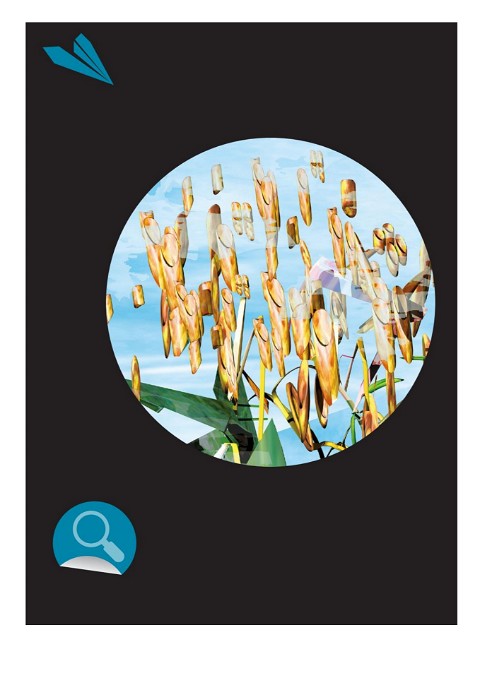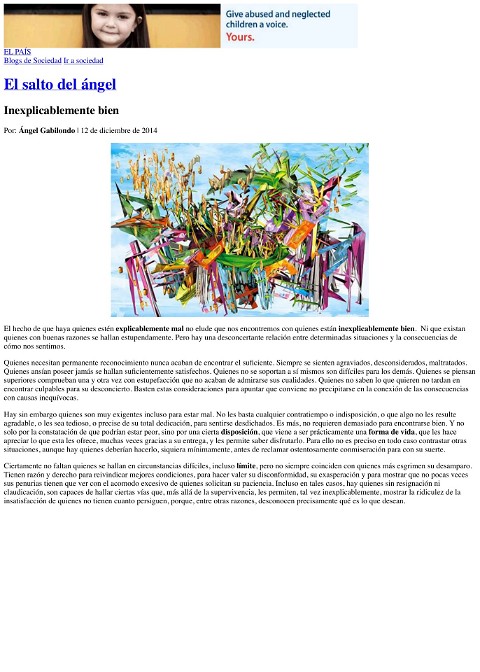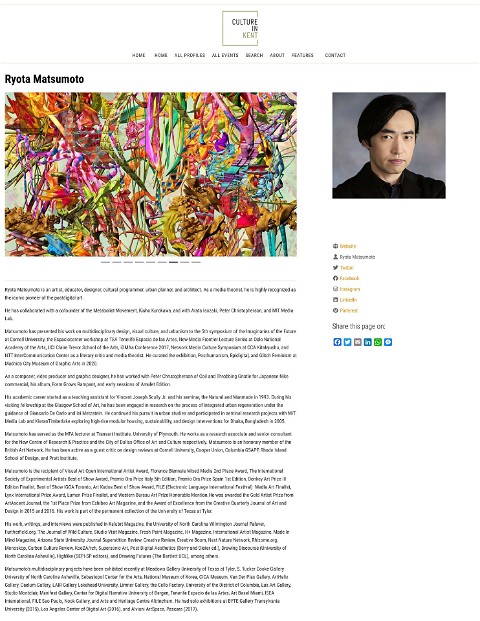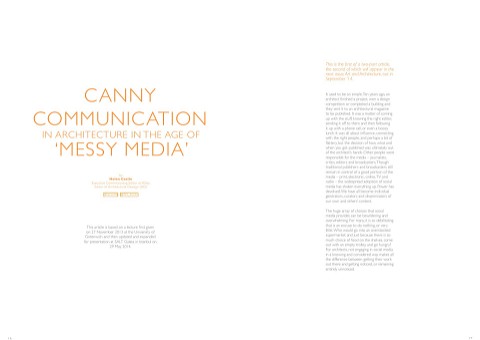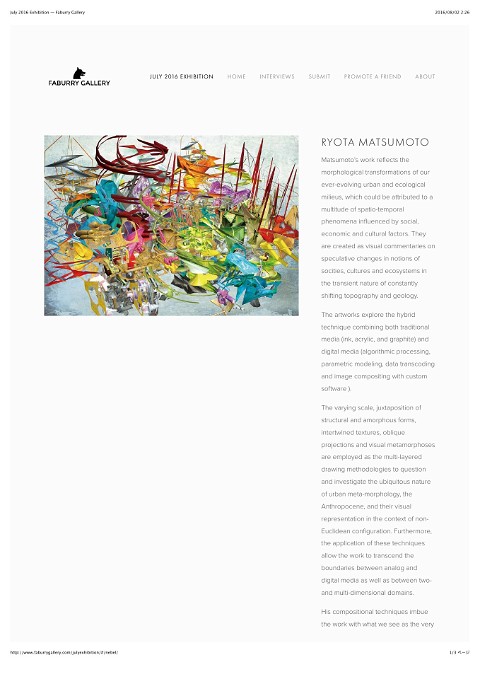CreativPaper / Ryota Matsumoto: New Media Art, Architecture, and Urbanism - 2016-2020
>100 Views
November 26, 23
スライド概要
Ryota Matsumoto (松本良多) is an artist, educator, designer, cultural programmer, urban planner, and architect. As a media theorist, he is highly recognized as the renowned pioneer and godfather of the postdigital culture.
Born in Tokyo, Matsumoto was raised in Hong Kong and Japan. He received a Master of Architecture degree from University of Pennsylvania in 2007 after his studies at Architectural Association in London, Mackintosh School of Architecture, Glasgow School of Art and University of Miami in early 90’s. He studied with Manuel DeLanda, Vincent Joseph Scully Jr., Cecil Balmond, and Giancarlo De Carlo, among others.
He has collaborated with a cofounder of the Metabolist Movement, Kisho Kurokawa, and with Arata Isozaki, Peter Christopherson, and MIT Media Lab.
Matsumoto has presented his work on multidisciplinary design, visual culture, and urbanism to the 5th symposium of the Imaginaries of the Future at Cornell University, the Espaciocenter workshop at TEA Tenerife Espacio de las Artes, New Media Frontier Lecture Series at Oslo National Academy of the Arts, UCI Claire Trevor School of the Arts, iDMAa Conference 2017, Network Media Culture Symposium at CCA Kitakyushu, and NTT InterCommunication Center as a literary critic and media theorist. He curated the exhibition, Posthumanism, Epidigital, and Glitch Feminism at Machida City Museum of Graphic Arts in 2020.
As a composer, video producer and graphic designer, he has worked with Peter Christopherson of Coil and Throbbing Gristle for Japanese Nike commercial, his album, Form Grows Rampant, and early sessions of Amulet Edition.
His academic career started as a teaching assistant for Vincent Joseph Scully Jr. and his seminar, the Natural and Manmade in 1993. During his visiting fellowship at the Glasgow School of Art, he has been engaged in research on the process of integrated urban regeneration under the guidance of Giancarlo De Carlo and Isi Metzstein. He continued his pursuit in urban studies and participated in seminal research projects with MIT Media Lab exploring high-rise modular housing, sustainability, and design interventions for Dhaka, Bangladesh in 2005.
Matsumoto has served as the MFA lecturer at Transart Institute, University of Plymouth. He works as a research associate and senior consultant for the New Centre of Research & Practice and the City of Dallas Office of Art and Culture respectively. Matsumoto is an honorary member of the British Art Network. He has been active as a guest critic on design reviews at Cornell University, Cooper Union, Columbia GSAPP, Rhode Island School of Design, and Pratt Institute.
Matsumoto is the recipient of Visual Art Open International Artist Award, Florence Biennale Mixed Media 2nd Place Award, The International Society of Experimental Artists Best of Show Award, Premio Ora Prize Italy 5th Edition, Premio Ora Prize Spain 1st Edition, Donkey Art Prize III Edition Finalist, Best of Show IGOA Toronto, Art Kudos Best of Show Award, FILE (Electronic Language International Festival) Media Art Finalist, Lynx International Prize Award, Lumen Prize Finalist, London International Creative Competition Honorable Mention, and Western Bureau Art Prize Honorable Mention. He was awarded the Gold Artist Prize from ArtAscent Journal, the 1st Place Prize from Exhibeo Art Magazine, and the Award of Excellence from the Creative Quarterly Journal of Art and Design in 2015 and 2016. His work is part of the permanent collection of the University of Texas at Tyler.
His work, writings, and interviews were published in Kalubrt Magazine, the University of North Carolina Wilmington Journal Palaver, Furtherfield.org, The Journal of Wild Culture, Studio Visit Magazine, Fresh Paint Magazine, H+ Magazine, International Artist Magazine, Made In Mind Magazine, Arizona State University Journal Superstition Review, Creative Review, Creative Boom, Next Nature Network, Rhizome.org, Monoskop, Carbon Culture Review, KooZA/rch, Supersonic Art, Post Digital Aesthetics (Berry and Dieter ed.), Drawing Discourse (University of North Carolina Asheville), Highlike (SEPI-SP editors), and Drawing Futures (The Bartlett UCL), among others.
Matsumoto’s multidisciplinary projects have been exhibited recently at Meadows Gallery University of Texas at Tyler, S. Tucker Cooke Gallery University of North Carolina Asheville, Sebastopol Center for the Arts, National Museum of Korea, CICA Museum, Van Der Plas Gallery, ArtHelix Gallery, Caelum Gallery, LAIR Gallery Lakehead University, Limner Gallery, the Cello Factory, University of the District of Columbia, Lux Art Gallery, Studio Montclair, Manifest Gallery, Center for Digital Narrative University of Bergen, Tenerife Espacio de las Artes, Art Basel Miami, ISEA International, FILE Sao Paulo, Nook Gallery, and Arts and Heritage Centre Altrincham. He had solo exhibitions at BYTE Gallery Transylvania University (2015), Los Angeles Center of Digital Art (2016), and Alviani ArtSpace, Pescara (2017).
関連スライド
各ページのテキスト
INTERVIEW /RYOTA MATSUMOTO For better or for worse, as a species, we have had the most impact on the landscape of our planet. Observable from space, we have altered the face of our planet, illuminating and moulding it to meet our needs. Artist Ryota Matsumoto’s work explores these relationships and changes, taking the form of visual commentaries of our dynamic landscape. Would you say that every aspect of our lives is influenced by art in one way or another? Yes, We are able to draw something rather banal, and it manages to speak a lot by itself. A simple object could be infused with a lot of anecdotes and memories with just brushes and a canvas. It proves the point that we are always inspired and influenced by every aspect of our lives and even ordinary matters that surround us and vice versa. 22 Do you think we could ever curtail our negative impact on the planet since the beginning of the Anthropocene? First thing first, we need to look at the Anthropocene from a broader geological perspective rather than human-centric or academic one. We also need to be aware of the urgent proximity of nonhuman presences. The other crucial point is how much we could let the public to be aware of this grave situation that we are hopelessly mired in.
Above: Surviving in the Multidimensional Space of Cognitive Dissonace. 23
That would lead to set up effective grassroots organisations for coming face to face with the Anthropocene epoch as well as addressing the myriad of related environmental issues. In a nutshell, I believe that kind of shift in our outlook might eventually lead to curtailing our negative impact on the planet. collaborations among them lately, and they certainly blur the boundaries among them. I’d say that art is the glue to hold together different disciplines as it is the best medium to inform creative thinking. As someone who uses multiple mediums, If you had to pick between digital and analogue techniques to create art, what What are you trying to would it be and why? communicate through your work I would embrace analogue as an artist? technique for creating art My work reflects the wholeheartedly, as that is what I am morphological transformations of familiar with long before the start our manifold ecological milieus of the digital revolution in both that are attributed to a multitude of architecture and fine art in the first spatiotemporal phenomena place. To be honest, I am weary of influenced by sociocultural and constant firmware updates of urban built environments. They are digital tools almost on a monthly created as visual commentaries on basis. speculative changes in notions of societies, cultures and ecosystems People often refer to Japan and in the transient nature of shifting Tokyo specifically as the future of and adaptive topography and cities around the world. Are there geology. lessons learnt that we could all benefit from? Do you think the lines between That is mostly the weird myth various disciplines are blurring primarily created by some notable with each passing day? science fiction films and novels I’d say so for some disciplines such in the west, I believe. Moreover, as art, science and I speculate that strange blend of architecture specifically. There are a street signs in both English and lot of cross-disciplinary Japanese in the centre of Tokyo 24
Above: Swirling Effects and Their Wayside Phenomena. 25
Above: The Indistinct Notion of an Object Trajectory. 26
probably conjure up the illusion of the future cities. As far as I can tell, I think most of the Japanese cities aren’t that different from cities in the rest of the world. It actually hits home for me that how much NY projects the future of cities considerably more so than Japanese cities with all those mega skyscrapers and huge logistical systems in Manhattan. Does Ryota have a morning routine? I tend to be a night owl and hardly ever have time for a morning routine, to be honest. It’d be nice to practice. Tai Chi or go jogging in the morning for my well being, of course. That is only an ideal anyway. www.ryotamatsumoto.com Could you tell us a bit more about your time growing up in Hong Kong? I used to live in Hong Kong from the mid-70s to late 80s. That was when Hong Kong went through the drastic transformation from a tiny seaport town to one of the most prosperous business cities of the world. It might have influenced me enormously in academic respect, as that experience led me to study both architecture and urbanism in hindsight. Has the past year had any specific highlights for you? I had received two first-place awards for the artworks from Visual Art Open in the UK and ISEA of the United States last year. Those are undoubtedly memorable events as an artist thus far. 27
INTERVIEW /RYOTA MATSUMOTO Ryota Matsumoto’s work reflects the morphological transformations of our ever-evolving urban and ecological milieus that are attributed to a multitude of spatiotemporal phenomena in influenced by social, economic and cultural factors. They are created as visual commentaries on speculative changes in notions of societies, cultures and ecosystems in the transient nature of constantly shi ing topography and geology. The artworks explore the hybrid technique combining both traditional media (ink, acrylic, and graphite) and digital media (algorithmic processing, parametric modelling, data transcoding and image compositing with custom software). The varying scale, a juxtaposition of biomorphic forms, intertwined textures, oblique projections and visual metamorphoses are employed as the multi-layered drawing methodologies to question and investigate the universal nature of urban meta-morphology, the eco-political reality of the Anthropocene epoch, the advancement of biomaterial technologies and their visual representation in the context of non-Euclidean configuration. Furthermore, the application of these techniques allows the work to transcend the boundaries between analogue and digital media as well as between two and multi-dimensional domains. www.ryotamatsumoto.com
The Indistinct Notion of an Object Trayectory.
High Frequency Captured on the Surface of Augmented Objects. Tell us a bit about Ryota Matsumoto Studio and the work it does? Ryota Matsumoto Studio is an interdisciplinary research laboratory that operates across the field of architecture, art and design. We adopted a synergistic approach to investigate a multitude of spatio-temporal phenomena of urban and ecological milieus at all scales. Currently, we are based in Tokyo, but there are correspondents in Berlin and New York to be engaged in a diversity of projects. As for now, we focus on developing a software that incorporate a recursive and reconfigurable algorithm based on multi-agent biological principals. It is capable of composing a hybrid image from the plethora of visual media driven by its own self-adaptive system. Some of my future media art are likely to reflect the outcome of this ongoing project.
The Chronology of Imaginary Scrolls. You also refer to yourself as an Urban Planner, Tell us a bit more about that and how that intertwines with your art? I’ve undertaken some of the major urban development projects in China, Vietnam and Tokyo over the course of my career as an urban planner. The experiences certainly inspire and motivate me to explore and question both ecological and ethical issues of the urban sustainable environment that have been influenced by the social and political realities of the Anthropocene epoch through my art, albeit with the use of visual semantics, analogies and metaphors. Your work comprises of complex layers and elements. How do you begin a painting and how long does each piece take on average? My drawing process involves base images that are composed by parametric and algorithmic design techniques.
Then they are merged and overlaid with traditional media such as acrylic, ink and graphite, as well as transcoded audio-visual data. These are further processed and looped through a series of arithmetic and stochastic operations by image editing programs and their custom plugins. The hybrid technique allows for a certain degree of unpredictability of visual dynamics. At the same time, painterly, organic sentiments of traditional media reveal themselves amidst the otherwise detached precision of digital drawings. identity and style then. How did that influence you as someone originating from Japan? My experience of living and studying in London and Glasgow in early ‘90s has certainly fostered my creativity and helps me to approach things from multiple angles. It was a few years before the digital tools and fabrications entered into the realm of architectural education. So greater emphasis was placed on theoretical discourses inspired by the work of continental thinkers and the discussions on Could you tell us a bit about the those themes facilitated the Metabolist movement and your exchange of ideas among students. involvement in it? Moreover we were trained to work I have collaborated with Kisho as a bridging point among Kurokawa, who was the founder of various disciplines and learned to Metabolist movement, on the pick things up quickly from campus master plan project in different fields and apply them to Fukuoka prefecture for several resolve any issues in our design years in the late ‘90s. Prior to that, projects from early on. I’ve worked briefly with Isozaki Arata, another associate of Consequently, interdisciplinary the movement for the landscape thinking comes naturally to me design of the healthcare facilities in and I guess that kind of a critical Tokyo. thinking mindset is indispensable for the development of one’s You spent a substantial time in artistry. London and Glasgow in the early 90’s. Art certainly had its own
Transient Field in the Air. If you could mention three benefits about being a Japanese artist what would they be? I can’t really think of any off the top of my head. But suffice it to say that some people can’t quite put the finger on what makes us tick as we aren’t generally known to wear our hearts on our sleeves, thereby most people don’t have much preconceived notions about what we would do. That enables us to explore creativity in our chosen field in depth and without much constraint. I don’t know if this actually counts as a benefit though. A lot of individuals consider being an artist a difficult profession to sustain, especially when making a living is concerned. What are your thoughts on that? As a struggling artist and designer myself, I could only convince myself and accept the fact that the financial stability is not my priority and make the best of every moment in my creative life.
